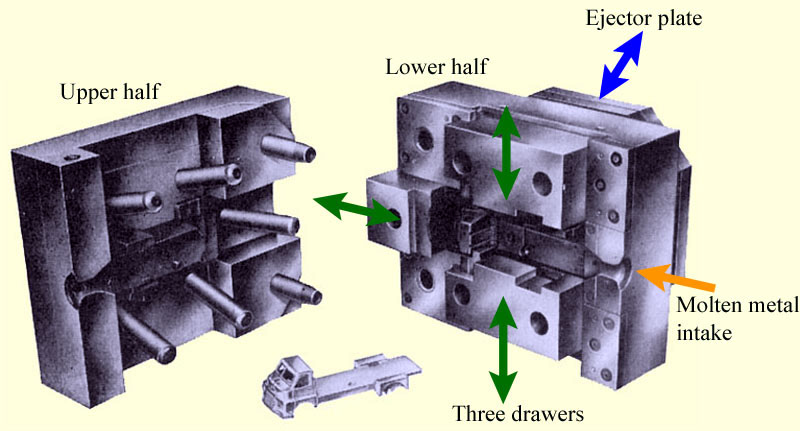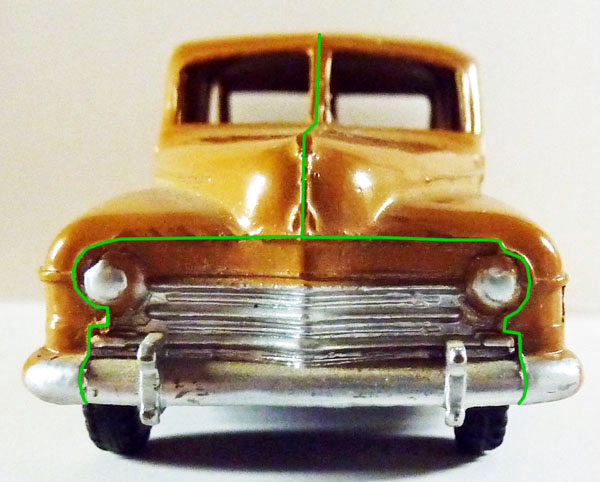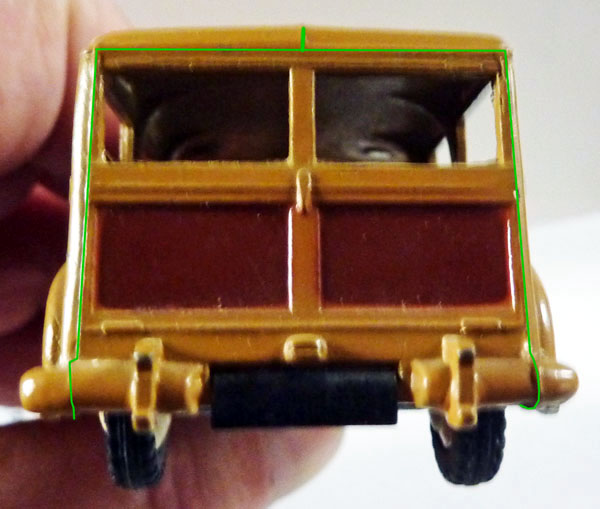Dinky Toys manufacturing.
This post has been transfered from the thread "Matching pictures).
I believe I have shown this photo once before. I used it as a demonstration that possibly a more or less squarish model was a bit easier to cast, allowing for a seam of the vertical halves in the middle.
The models on top are square and show that seam. The models below have more round shapes, which took more die- elements to cast in my opinion. So possibly, if there was an opportunity to make a more square model, the casting would be easier - and cheaper no doubt. Just a theory ....
Kind regards,
Jan

This is the die for the Big Bedford chassis and cab. It shows how things work.
When designing a die, one must take in account the shape of the casting to be made and where to hide the seems or die partition lines. In the case of the Plymouth, the Daimler ambulance and others, the seem are clearly visible on the roof but it is hiden in the center line of the bonnet.
The die for these models with vertical rear have four sliding drawers. The Big Bedford has two only. On the picture above, you can see that these drawers are square, they have a very tight fit with the other parts ofthe die so that there is no flash in between.
Jan is right, the rear of the Plymouth has been made square because otherwise the mobile part of the die on which the rear hatch is machined would have had a curved top which is probably possible but extremely difficult to make.
I am sorry but it is difficult for me to explain all this in English and in writing. If you wish, I could explain this verbally during the next AGM.


Partition lines for 27f Estate car.
Raised versus recessed door lines.
This discussion has started else where but I shall try to explain what I know about this subject.
Early Dinky Toys had raised door lines which do not comply with real vehicles. At that time (1933 - 1954) the moulds where cut by milling machines and these lines were easyer to do than recessed lines. The mould was first made smooth without lines, later the lines were ground.

Electrode for the Solido Peugeot D4 van
Then comes the new technology of spark erosion. Instead of copying a large scale wooden or resin master a solid copper sample of the model was used as an electrode which was used to cut the mould. The door lines were cut into the electrode and of course the mould had the lines inverted which means raised. In turn the casting had inverted lines from the mould and the finished product had recessed lines. Raised details like door handles, bonnet emblem and the like were still milled into the mould.
You have not understood, never mind give me a call and I will explain further.
The first Dinky Toys with recessed lines is certainly the Austin Atlantic issued in 1951. The die for this model has probably been sub contracted as at that time Meccano almost certainly did not have a spark erosion facility.

The next model was the 24v Buick Roadmaster issued in January 1954. Bobigny did not make it's own moulds, they were all subcontracted to specialised companies who had up to date equipement. Next came the 24y Studebaker Commander issued fourteen months later in June 1955 and the 24x Simca Versailles in March 1956.

Liverpool issued their first two recessed lines cars in January 1961 seven years after the Buick Roadmaster. These were the 195 Jaguar 3,4 l and the 185 Alfa Romeo Super Sprint but of course, this was a French casting. Next came the 186 Mercedes 220 SE, the 949 Wayne School bus in February 1961 followed by the 194 Bentley (which is not a coupe) in March 1961 and from then all the new models.

A caracteristic of these first English dinky, mainly the Jaguar and the Mercedes is their extremely light weight.
The seven year delay for introducing spark erosion in Binns Road may be partly due to the unions which at the time were reluctant to any new technology which of course used less labour. It is known that when the electrostatic painting line was installed, it took months before it was used thanks to the unions who discussed who would work on it, at which salary, with which bonus and all that fuss. No wander the company packed up.
Jacques, thank you very much for your clear technical explanation. It is very valuable that you provide this technical explanation. It makes understanding the making of the model with its lines so much more valuable. I am very happy with this kind of information from you with explanations and images in the forum and hope to enjoy your contributions much more.
Kind regards, Jan Oldenhuis
This is a question for Vic Mumby.
Dear Vic,
For a long time, I have wanted to know how the marking was done on the castings. Which technique was used ?
Thanks for your help.
Jacques
Hello Jacques,
I assume you mean the model number, Meccano Ltd, Made in England etc? The letters were machined into the plastic or diecast mould using a Pantograph reducing (copying) machine. On one side of the machine would be female large scale letters and numbers in reverse. The toolmaker would guide a stylus over the letters or numbers and a fine cutter on the other side of the machine would engrave the letters into the steel of the mould. The Pantograph would be set to apply the appropriate reduction in size from the masters to the mould. The engraving is female in the mould and in reverse so the finished product becomes male and reads correctly. Hope this helps.
Kind regards
Vic Mumby
Thank you Vic for this information.
Kind regards.
The pantograph milling machine from the Binns Road factory.



Hello Jacques and Jan,
I would like to add some comment on your prevoius discussion about raised or sunken detail door/bonnet/boot lines. When I started my toolmaking apprenticeship at Binns Road in 1961 all body castings were being produced with sunken lines, although with the eventual introduction of opening doors etc, sunken lines were needed less. This was achieved without EDM (Spark Erosion). Binns Road did not get it's first EDM machine until Mid '60's and it was used for other more intricate purposes than car body tooling.
The late aquisition of the EDM machine had nothing at all to do with union resistance; in fact the toolmakers at Binns Road were only to pleased to have any new technology. Meccano was one of the first companies to install 3 of the newly developed Bridgeport Universal Milling Machines during the '60's.
Anyway, getting back to the sunken detail lines. These were achieved by carving them into the 3 or 4 times full scale wooden patterns. Developments in superior casting resins mean't that the female castings taken from the wooden pattern were very robust and resist any damage when the stylus of the Pantograph machine was traced over them and came into contact with the raised detail that produced the sunken lines in the finished product.
Meccano also used specialist toolmakers especially in the 70's when Binns Road had insufficient capacity to meet the very busy Dinky product program which at that time was to release TWO models per month. These toolmakers had access to very high quality pattern makers. These subcontracted patterns would be submitted to the Drawing Office at Binns Road for approval before die cutting could commence.
Toolmaking has always facinated me and during the whole of my working career I have been able to follow and utilise the technological advances as they occured.
Vic
Hello Jan,
I cannot offer a definate explanation as to why the Austin Atlantic has sunken lines. The model was introduced in 1951 when EDM machining was in it's infancy/being developed and certainly not at Binns Road.
The only logical possibility I can offer is that the lines were produced as I have previously described as an experiment; but the effort of trying to do the copying on the pantograph without breaking the fragile raised lines on the early castings taken from the wooden pattern was very time consuming and the idea abandoned until superior casting resins appeared.
My elder brother (now 90 years old) was a toolmaker at Meccano during the time of manufacture and introduction of the Austin Atlantic. He may recall some facts about the car. I will ask him about it.
Vic
Did Meccano Liverpool perhaps use resin as diecast metal for model 195 Jaguar 3.4 liter saloon (August 1960 - with recessed lines)? When I got the model I was amazed at the light weight of the model. It weighs 52 grams. For example, the Model 176 Austin A105 (April1958 - with raised lines) is heavier and weighs 86 grams. The body of the 195 is much thinner than that of the 176.
Was another diecast metal used at the same time as the erosion spark technique? From a cost saving standpoint I would think that using thinner metal saves production costs?
Jan Oldenhuis 8 April 2022
Hello Jan,
I can offer no logical explanation as to the light weight of the Jaguar other than it's general wall thickness was reduced as an experiment. Certainly in the late 1970's general wall thickness was officially reduced from 1mm to 0.8mm a saving of 20%; without any appreciable loss in strength. If you have an Austin Princess DT 123, it is also very light with 0.8mm wall thickness.
Obviously you cannot have 0.8mm everywhere because creating the natural contours of a model produces thicker areas. Following these contours internally at 0.8mm would require undercuts. Creating undercuts makes tooling extremely difficult and more expensive.
Binns Road never released production models in resin.
Kind regards
Vic
Hello Vic. Thank you very much for your much appreciated and valuable explanation. We are fortunate to hear a representative of the Meccano factory Liverpool after so many years.
Sincerely, Jan Oldenhuis.
The Mercedes 220 SE ref. 186 is also a light weight model like the Jaguar
Interesting manufacturing comparison between UK 192 De Soto Fireflite and French 545 De Soto Diplomat:
Each model has its own production details. It only becomes fun for a collector if he knows all these details and can make comparisons with similar models and can explain the differences.
I enjoy comparing models and explaining the differences and putting them on paper. It increases my knowledge and pleasure to look at it that way and to share my findings with other collectors and to be open to additions or corrections.
Dinky Toys manufacturing is not my specialty but it has my great interest and I follow contributions about that with interest because I find the production method of a model interesting to know. By reading contributions in the forum and participating in it yourself, I learn about it and can find interesting comparisons of models.
Difference in doorlines:
For example, I find UK model 192 De Soto Fireflite interesting to compare with French model 545 De Soto Diplomat. It should be noted that model 192 was produced in December 1958 and model 545 only a year later in December 1959. Meccano Bobigny used the erosion spark technique with model 545, which Meccano Liverpool could not yet do in 1958. As a result, you can clearly see the external differences in doorlines. 192 clearly has raised lines as opposed to deepened lines of the 545. Still, I like to show this comparison, because both models are of the same USA brand name car manufacturer De Soto, but model 192 were manufactured by Meccano Liverpool and model 545 by Meccano Bobigny.

Below - 545 with deepened lines; above - 192 with raised lines.
Difference in roof painting:
It is also interesting to compare the way of painting the roof of both models. It is immediately noticeable that the roof of the 192 is painted with a generous free space all around up to the windows and is applied on a raised platform, while the roof of the 545 is completely flat and painted up to the windows.

Below - 192 with raised painted roof with space around till windows party. Above - 545 with flat painted roof till windows party.
This raised way of painting the roof of the 192 is mysterious and described by Bruce Hoy in topic 192. Why was the paint of the roof applied to a raised platform, while the real 1957 De Soto Fireflite was never executed that way?
The application of spun wheels:
In December 1958, the Model 192 was the first UK model to be fitted with spun hubs, but not yet with 4 wheel suspension. That only came on 18-3-1960.
Model 545 was the 1st French model that was equipped with 4 wheel suspension. Before that, it had to be done with spun hubs instead of ridged hubs, as drawn by Jean Massee on the 545 box. Due to the bulging outwards of the ridged hubs, there was not enough room for the suspension for the model and had to be changed to a flat wheel hub.

Ridged hubs on box 545, drawn by Jean Massee, but never performed. It got spun hubs needed for 4 wheel suspension.
Difference in window styles:
545 is executed without window styles. They are incorporated in the plastic windows. 192 is executed with door window styles as pictured below.

545 without door window styles. They are incorporated in the plastic windows.

192 with door window styles.
Difference in baseplate:

Dinky Toys 192 De Soto Fireflite Sedan base Bruce Hoy DTCA with number 192, without 4 wheel suspension and without model year.

Dinky Toys 545 De Soto Diplomat with number 545, with 4 wheel suspension and one of the few Dinky Toys with the model year entry 59 in the base. Striking is the absence on the base plate of the patent number for the 4 wheel suspension!
Difference in headlamps:
192 had single headlamps - 545 had dual headlamps.

192 with single headlamps as explained by Bruce Hoy in topic 192.

545 with dual headlamps.
So you see that there are many interesting differences to find between certain models. It is very fun and educational to discover that and to explain.
Jan Oldenhuis, 20 April 2022.
Hello Jan,
I don't think there are any mysteries here. The two models are of two completely different cars produced by De-Soto. One explanation for the raised painted roof panel on the FireFlite is the option of a fold back sun roof which could not extend to the extreme edges of the roof because structural integrity would have to be maintained.
Vic Mumby 20 April 2022
Thank you Vic for your valued response. The question about the method of painting the roof of the 192 has clearly been solved by you. Thank you for that. My intention was only to highlight the optical differences of these 2 different De Soto models and to name the individual details of the models. Because the 192 was made by Meccano Liverpool and the 545 by Meccano Bobigny, I thought it would be interesting to compare them optically, knowing that they are different models and were also made with a gap of a year. I always try to mention some interesting details with a contribution on the forum.
Jan Oldenhuis, 21 April 2022
I think Vic may be right when he says that the painted portion of the 192's roof is meant to simulate a folding cloth sunroof. It was an odd choice for the model, however, since that certainly was not a very common option on American cars of the time.
Regarding what Jan has termed "window styles," the explanation there of course is that the 192 is a model of a standard sedan with framed windows. The 545 is a model of a "hardtop," which is a sedan that has frameless windows and no "B" pillar. When all the glass is rolled down, the window area is totally open, as it would be on a convertible.
Hardtops were always more expensive and the frameless glass tended to rattle, and they have become a rarity. Another example of a hardtop Dinky is the 147 Cadillac 62. (It was doubly inappropriate that Dinky later turned this model into a police car, since police departments would never have chosen an expensive Cadillac, and supposing they did, they would surely have selected the less-expensive standard sedan, not the extra-costly hardtop.)
See https://www.hemmings.com/stories/article/a-history-of-hardtops for more information on American hardtops.
Jon--Good points and well explained. Am not sure if it was discussed earlier, but another interesting comment about the DeSoto Diplomate is that it was an export only model made by the Chrysler Corp., and was really a Plymouth body that had a DeSoto front end grafted on to it. But the comparison was interesting and also shows the differences between how Bobginey made models and Binn's Rd. There were always differences in how the two companies detailed and painted their models too.
Best regards, Terry












-105c and 383 4-Wheel Hand Truck (1949-1958)
-105c and 383 4-Wheel Hand Truck (1949-1958)
DTCAwebsite upgrade 2023
DTCAwebsite upgrade 2023
DTCAwebsite upgrade 2023
DTCAwebsite upgrade 2023
DTCAwebsite upgrade 2023
DTCAwebsite upgrade 2023
DTCAwebsite upgrade 2023
DTCAwebsite upgrade 2023
DTCAwebsite upgrade 2023
DTCAwebsite upgrade 2023
DTCAwebsite upgrade 2023
DTCAwebsite upgrade 2023
DTCAwebsite upgrade 2023
--22c Motor Truck (1933-50)
--22c Motor Truck (1933-50)
DTCAwebsite upgrade 2023
DTCAwebsite upgrade 2023
Trailer Caravans
Trailer Caravans
DTCAwebsite upgrade 2023
DTCAwebsite upgrade 2023
DTCAwebsite upgrade 2023
DTCAwebsite upgrade 2023
Trailer Caravans
Trailer Caravans
-138 Hillman Imp (1963-73)
-537 Renault 16 TL
-189 Triumph Herald Saloon (1959-64)
-255 Mersey Tunnel Police Van (1955-61)
DTCAwebsite upgrade 2023
-189 Triumph Herald Saloon (1959-64)
-189 Triumph Herald Saloon (1959-64)
-674 Austin Champ (1954-71)